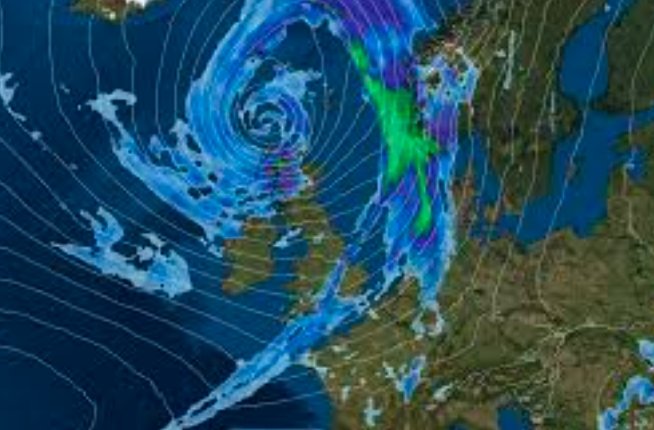Scotland faces the fury of Storm Amy today, the first named storm of the season, bringing fierce winds and heavy rain to the north and west. Experts warn that the storm’s intense low pressure could drop water’s boiling point to 98 degrees Celsius in some areas, potentially ruining the flavor of that essential evening cup of tea.
Storm Amy Builds Strength Over the Atlantic
Storm Amy formed quickly as it crossed the Atlantic, drawing energy from remnants of a distant hurricane. Meteorologists track it heading straight for northwest Scotland, where it will peak late Friday into early Saturday. This rapid growth, known as explosive cyclogenesis, pushes the system to near record lows for October pressure levels.
The storm already disrupts daily life across the UK. Early reports show yellow warnings for rain in place since Thursday, with totals building to 30 to 50 millimeters in many spots. Higher ground in the Highlands could see up to 80 millimeters, raising flood risks in vulnerable valleys.
Communities prepare for the onslaught. Power companies deploy extra crews to handle outages, while local councils clear drains to fight surface water buildup. Recent events like last year’s heavy rains in the same regions remind residents of quick flooding dangers.

Warnings Escalate as Winds Intensify
The Met Office upgraded alerts to amber for winds in northern and western Scotland from 5pm Friday until 9am Saturday.1
Rain adds to the chaos, with persistent downpours expected overnight. Northern Ireland sees 20 to 30 millimeters, while Scotland’s west takes the brunt. Flooding already hits some roads, and more closures loom as the storm advances.
Public response mixes caution with routine. Social media buzzes with tips on securing gardens and stocking essentials. One recent parallel, Storm Ciarán in 2023, brought similar low pressure and caused widespread travel halts, underscoring the need for vigilance.
| Region | Expected Wind Gusts (mph) | Rainfall (mm) | Key Risks |
|---|---|---|---|
| Northwest Scotland | 80-95+ | 50-80 | Flooding, power cuts, coastal damage |
| Northern Scotland | 60-80 | 30-50 | Travel delays, debris hazards |
| Central Belt | 50-70 | 20-40 | Urban flooding, minor disruptions |
| Northern Ireland | 40-60 | 20-30 | Strong coastal winds, rain |
Travel Faces Major Disruptions
Rail services grind to a halt in key areas. ScotRail suspends lines from Mallaig to Fort William, Fort William to Crianlarich, Inverness to Aberdeen, and Inverness to Wick and Thurso starting 6pm Friday for safety.2 Passengers face revised schedules or cancellations into the weekend.
Roads turn treacherous with surface water and fallen trees. Police advise avoiding non-essential trips, especially in the Highlands where bridges may close. Ferries to the Western Isles cancel sailings, stranding some travelers.
Airports monitor closely, but flights hold steady so far. One cancellation hit Dublin to Amsterdam early Friday due to gusts.3 Broader impacts echo past storms, like when high winds grounded services across the UK last autumn.
Low Pressure Alters Boiling Point Basics
At the heart of the storm lies a quirky science fact: low atmospheric pressure lowers water’s boiling point. In northwest Scotland tonight, it may dip to 98 degrees Celsius, below the ideal 100 degrees for black tea extraction.4 This subtle shift reduces tannin release, leading to weaker flavor in brews.
Atmospheric experts explain the process clearly. Pressure drops as the storm deepens, mimicking high altitude effects where water boils cooler. During explosive cyclogenesis, this intensifies almost twice the normal rate, setting a potential October record off Scotland’s coast.
Similar events occurred before. In 2023, Storm Ciarán dropped boiling points in southern England to 98 degrees, affecting millions of morning cups.5 Tasters noted a discernible blandness, proving the impact real even if minor.
Tea Lovers Adapt to the Challenge
Rachael Robertson, owner of a Highlands tea company, shares practical insights. She stresses quality leaves and water matter most, but temperature plays a key role in black tea’s full body. Her blends, sourced globally, aim for perfection at straight-off-boil pours.
Even a two-degree drop might not ruin every sip, Robertson notes. Many may not notice amid the storm’s roar. Still, she recommends experimenting with green tea, which brews best at 80 degrees Celsius and withstands lower heats.
- Secure outdoor items like bins and garden furniture to prevent flying hazards.
- Charge devices and keep torches ready for potential power outages.
- Check travel apps for real-time updates on trains and roads.
- Stock non-perishables and bottled water in case of flooding.
- Opt for herbal infusions if black tea tastes off due to pressure.
Stay Safe and Share Your Storm Stories
As Storm Amy unleashes its power, communities rally with neighborly checks and online support. Logical steps now prevent bigger issues later, drawing from lessons of recent wet winters. This event highlights climate patterns bringing early storms, urging better preparedness nationwide.
Readers, how will you weather the gale? Share your tips or tea alternatives in the comments below, and pass this article to friends facing the winds.


















